CHEVROLET CAMARO 2021 High Performence
Manufacturer: CHEVROLET, Model Year: 2021, Model line: CAMARO, Model: CHEVROLET CAMARO 2021Pages: 49, PDF Size: 17.72 MB
Page 21 of 49
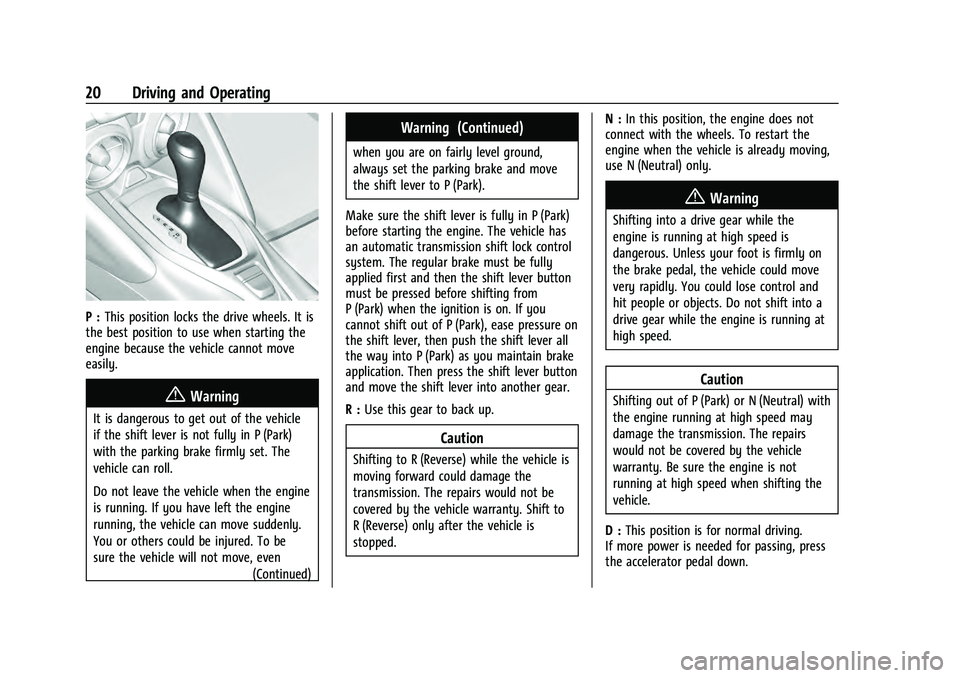
Chevrolet Camaro High Performance Owner Manual Supplement (GMNA-
Localizing-U.S./Canada/Mexico-14584225) - 2021 - CRC - 9/30/20
20 Driving and Operating
P :This position locks the drive wheels. It is
the best position to use when starting the
engine because the vehicle cannot move
easily.
{Warning
It is dangerous to get out of the vehicle
if the shift lever is not fully in P (Park)
with the parking brake firmly set. The
vehicle can roll.
Do not leave the vehicle when the engine
is running. If you have left the engine
running, the vehicle can move suddenly.
You or others could be injured. To be
sure the vehicle will not move, even
(Continued)
Warning (Continued)
when you are on fairly level ground,
always set the parking brake and move
the shift lever to P (Park).
Make sure the shift lever is fully in P (Park)
before starting the engine. The vehicle has
an automatic transmission shift lock control
system. The regular brake must be fully
applied first and then the shift lever button
must be pressed before shifting from
P (Park) when the ignition is on. If you
cannot shift out of P (Park), ease pressure on
the shift lever, then push the shift lever all
the way into P (Park) as you maintain brake
application. Then press the shift lever button
and move the shift lever into another gear.
R : Use this gear to back up.
Caution
Shifting to R (Reverse) while the vehicle is
moving forward could damage the
transmission. The repairs would not be
covered by the vehicle warranty. Shift to
R (Reverse) only after the vehicle is
stopped. N :
In this position, the engine does not
connect with the wheels. To restart the
engine when the vehicle is already moving,
use N (Neutral) only.
{Warning
Shifting into a drive gear while the
engine is running at high speed is
dangerous. Unless your foot is firmly on
the brake pedal, the vehicle could move
very rapidly. You could lose control and
hit people or objects. Do not shift into a
drive gear while the engine is running at
high speed.
Caution
Shifting out of P (Park) or N (Neutral) with
the engine running at high speed may
damage the transmission. The repairs
would not be covered by the vehicle
warranty. Be sure the engine is not
running at high speed when shifting the
vehicle.
D : This position is for normal driving.
If more power is needed for passing, press
the accelerator pedal down.
Page 22 of 49

Chevrolet Camaro High Performance Owner Manual Supplement (GMNA-
Localizing-U.S./Canada/Mexico-14584225) - 2021 - CRC - 9/30/20
Driving and Operating 21
Caution
If the vehicle does not shift gears, the
transmission could be damaged. Have the
vehicle serviced right away.
Performance Shifting
While driving in Sport Mode and Track
Mode, if Tap Shift has not been activated,
the transmission determines when the
vehicle is being driven in a competitive
manner. The transmission may remain in a
gear longer than it would in the normal
driving mode based on throttle input and
vehicle lateral acceleration. If there is a rapid
reduction in throttle from a heavy throttle
position at high rpm, the transmission will
maintain the current gear up to near redline
rpm. While braking, the transmission will
automatically downshift to the next lower
gear keeping engine speed above
approximately 3000 rpm. If the vehicle is
then driven for a short time at a steady
speed, and without high cornering loads, the
transmission will upshift one gear at a time,
until 10 (Tenth) gear. After shifting to
10 (Tenth) gear, or coming to a complete
stop, the transmission will return to normal
Sport Mode shifting.
Ride Control Systems
Competitive Driving Mode
Competitive Driving Mode, Performance
Traction Management, and Launch Control
are systems designed to allow increased
performance while accelerating and/or
cornering. This is accomplished by regulating
and optimizing the engine, brakes, and
suspension performance. These modes are
for use at a closed course race track and are
not intended for use on public roads. They
will not compensate for driver inexperience
or lack of familiarity with the race track.
Drivers who prefer to allow the system to
have more control of the engine, brakes,
and suspension are advised to turn the
normal Traction Control System (TCS) and
StabiliTrak/Electronic Stability Control
(ESC) on.
Caution
Attempting to shift when the drive
wheels are spinning and do not have
traction may cause damage to the
transmission. Damage caused by misuse
of the vehicle is not covered by the
(Continued)
Caution (Continued)
vehicle warranty. Do not attempt to shift
when the drive wheels do not have
traction.
Competitive Driving Mode allows full engine
power while StabiliTrak/ESC helps maintain
directional control of the vehicle by selective
brake application. In this mode, TCS is off
and Launch Control is available. Adjust your
driving style to account for the available
engine power. See “Launch Control”later in
this section.
Do not use cruise control in performance
driving situations.
When StabiliTrak/ESC is in a performance
driving state by pressing
Ytwice for
Competitive Driving Mode or Performance
Traction Management Mode, or by pressing
and holding
Yfor five seconds to turn
StabiliTrak/ESC off, the cruise control
buttons on the left side of the steering
wheel will be inoperative.
To regain cruise control capability, press
Y
once to return to regular StabiliTrak/ESC
operation.
Page 23 of 49
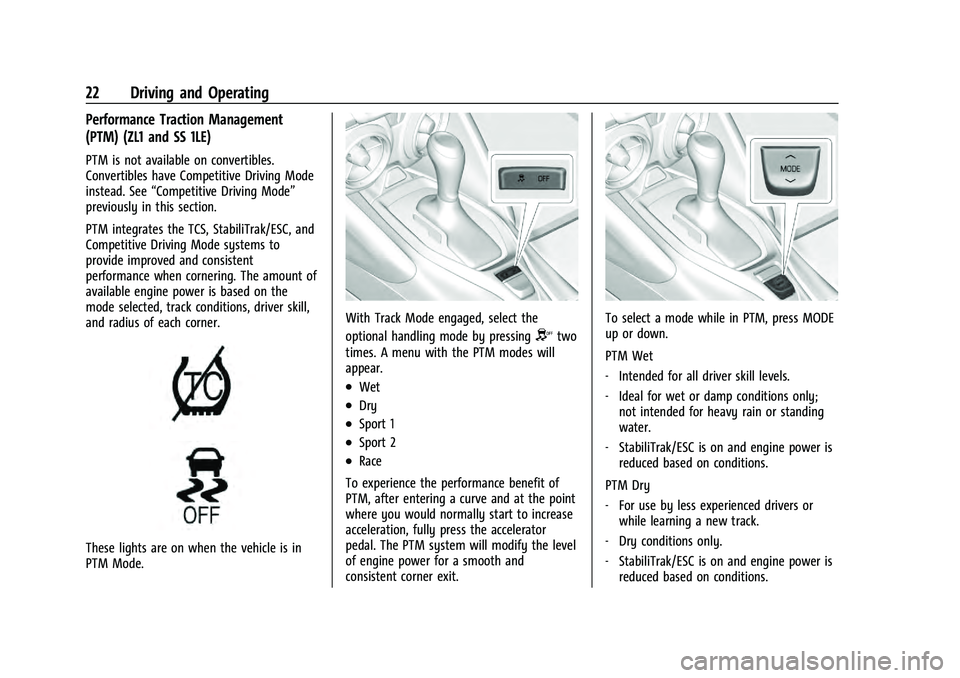
Chevrolet Camaro High Performance Owner Manual Supplement (GMNA-
Localizing-U.S./Canada/Mexico-14584225) - 2021 - CRC - 9/30/20
22 Driving and Operating
Performance Traction Management
(PTM) (ZL1 and SS 1LE)
PTM is not available on convertibles.
Convertibles have Competitive Driving Mode
instead. See“Competitive Driving Mode”
previously in this section.
PTM integrates the TCS, StabiliTrak/ESC, and
Competitive Driving Mode systems to
provide improved and consistent
performance when cornering. The amount of
available engine power is based on the
mode selected, track conditions, driver skill,
and radius of each corner.
These lights are on when the vehicle is in
PTM Mode.
With Track Mode engaged, select the
optional handling mode by pressing
Ytwo
times. A menu with the PTM modes will
appear.
.Wet
.Dry
.Sport 1
.Sport 2
.Race
To experience the performance benefit of
PTM, after entering a curve and at the point
where you would normally start to increase
acceleration, fully press the accelerator
pedal. The PTM system will modify the level
of engine power for a smooth and
consistent corner exit.
To select a mode while in PTM, press MODE
up or down.
PTM Wet
‐ Intended for all driver skill levels.
‐ Ideal for wet or damp conditions only;
not intended for heavy rain or standing
water.
‐ StabiliTrak/ESC is on and engine power is
reduced based on conditions.
PTM Dry
‐ For use by less experienced drivers or
while learning a new track.
‐ Dry conditions only.
‐ StabiliTrak/ESC is on and engine power is
reduced based on conditions.
Page 24 of 49

Chevrolet Camaro High Performance Owner Manual Supplement (GMNA-
Localizing-U.S./Canada/Mexico-14584225) - 2021 - CRC - 9/30/20
Driving and Operating 23
PTM Sport 1
‐For use by drivers familiar with the track.
‐ Dry conditions only.
‐ StabiliTrak/ESC is on and more engine
power is available than lower modes.
PTM Sport 2
‐ For use by drivers familiar with the track.
‐ Dry conditions only.
‐ StabiliTrak/ESC is off and engine power
available is the same as in Sport 1.
PTM Race
‐ For use by drivers familiar with the track.
‐ Dry conditions only.
‐ StabiliTrak/ESC is off and engine power is
available for maximum cornering speed.
In any PTM Mode, Launch Control is
available. Use PTM Race for the most
consistent performance during drag strip
use. See “Custom Launch Control” in Track
Events and Competitive Driving in the
owner’s manual.
Press and release
Yto turn off PTM and
return to TCS and StabiliTrak/ESC. The
traction off light
iand StabiliTrak/ESC OFF
light
gwill go out.
Launch Control
If equipped, Launch Control is available
within Competitive Driving Mode and
Performance Traction Management (PTM) to
allow high levels of vehicle acceleration in a
straight line. Launch Control is a form of
traction control that manages tire spin while
launching the vehicle. This feature is
intended for use during closed course race
events where consistent zero to
60 and quarter mile times are desirable.
Launch Control is only available when the
following criteria are met:
.Competitive Driving Mode is selected or
any of the Performance Traction
Management modes are selected. The
traction off light comes on in the
instrument cluster and the appropriate
Driver Information Center (DIC) message
displays.
.The vehicle is not moving.
.The steering wheel is pointing straight.
Manual Transmissions
.The clutch is fully pressed and the
transmission is in 1 (First) gear.
.The accelerator pedal is rapidly applied
and held to wide open throttle. Launch Control will initially limit engine
speed as you rapidly apply the accelerator
pedal to wide open throttle. Allow the
engine rpm to stabilize. A smooth, quick
release of the clutch, while maintaining the
fully pressed accelerator pedal, will manage
wheel slip.
Automatic Transmissions
.The brake pedal is firmly pressed to the
floor, equivalent to a panic brake event.
.The accelerator pedal is rapidly applied to
wide open throttle. If the vehicle rolls due
to wide open throttle, release the
throttle, press the brake pedal more
firmly, and re-apply the accelerator to
wide open throttle.
Launch Control will initially limit engine
speed as you rapidly apply the accelerator
pedal to wide open throttle. Allow the
engine rpm to stabilize. A smooth, quick
release of the brake pedal, while
maintaining the fully pressed accelerator
pedal, will manage wheel slip.
After the vehicle is launched, the system
continues in Competitive Driving Mode
or PTM.
Page 25 of 49

Chevrolet Camaro High Performance Owner Manual Supplement (GMNA-
Localizing-U.S./Canada/Mexico-14584225) - 2021 - CRC - 9/30/20
24 Driving and Operating
Competitive Driving Mode, PTM, and Launch
Control are systems designed for a closed
course race track and not intended for use
on public roads. The systems are not
intended to compensate for lack of driver
experience or familiarity with the race track.
Custom Launch Control may be available
through the Settings menu, if equipped. See
“Custom Launch Control”in Track Events and
Competitive Driving in the owner’s manual.
Limited-Slip Differential
The Electronic Limited-Slip Differential (eLSD)
is a hydraulically actuated clutch system.
It can infinitely vary the clutch engagement
between 0 and 2000 Y(1475 lb ft) of
breakaway torque between the rear wheels.
It responds to full engagement within
0.150 seconds when necessary. Smaller
clutch adjustments happen even faster.
The eLSD:
.Uses the vehicle sensors and driver inputs
to determine the optimum amount of
clutch engagement for the conditions.
.Improves traction while cornering by
changing the engagement to achieve a
balance between directional control and
acceleration.
.Provides optimal engagement for
high-speed control and stability without
affecting precise steering and turn-in.
.Improves vehicle stability during spirited
driving and evasive maneuvers. Is fully
integrated with the Active Handling and
Performance Traction Management (PTM)
systems.
There are unique calibrations based on the
Traction Control System (TCS) setting. eLSD
modes change automatically when
Yis
pressed. No unique input from the driver is
required.
.Mode 1 is the standard mode when the
vehicle is started. It provides a touring
calibration with an emphasis on vehicle
stability. Mode 1 is also used in PTM
Wet mode.
.Mode 2 is engaged when both TCS and
StabiliTrak/Electronic Stability Control
(ESC) are turned off. This calibration
provides more nimble corner turn-in, and
is biased for better traction out of
corners.
.Mode 3 is engaged when PTM is engaged
in Dry, Sport 1 & 2, and Race modes. This
is a nimble calibration with similar
functionality as eLSD Mode 2, however, it
is integrated to work with PTM.
.Mode 4 is engaged when TCS is selected
off, but StabiliTrak/ESC remains on.
Vehicle stability is still the priority, while
allowing for optimized traction out of
corners.
The ZL1 1LE, ZL1 coupe, and SS 1LE are
calibrated uniquely and optimized for their
unique powertrain and chassis combinations.
Fuel
Top Tier Fuel
GM recommends the use of TOP TIER
Detergent Gasoline to keep the engine clean,
reduce engine deposits, and maintain
optimal vehicle performance. Look for the
TOP TIER Logo or see www.toptiergas.com
for a list of TOP TIER Detergent Gasoline
marketers and applicable countries.
Page 26 of 49
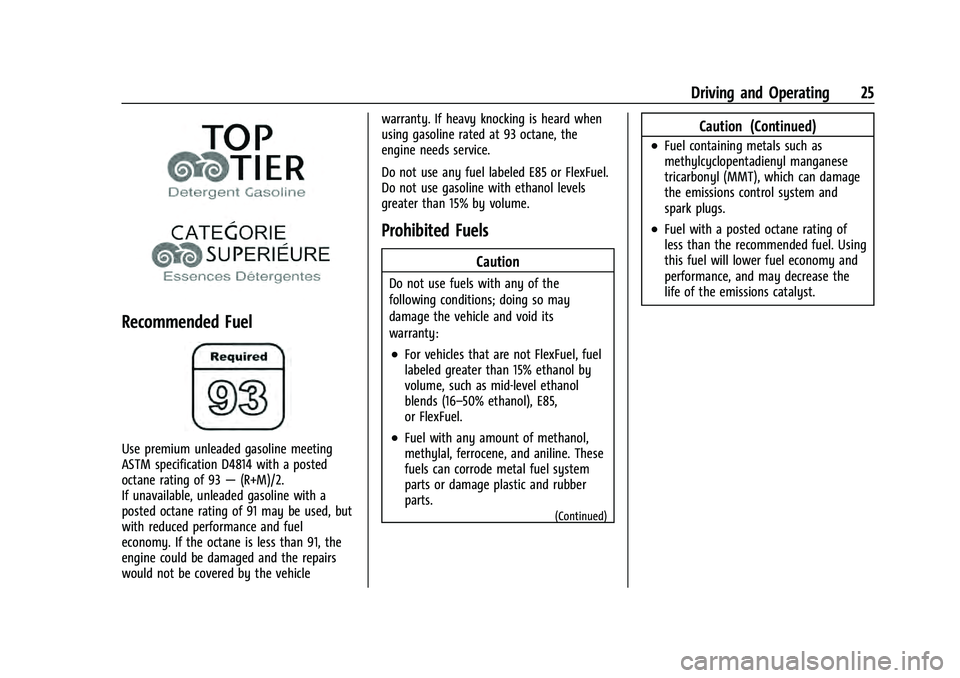
Chevrolet Camaro High Performance Owner Manual Supplement (GMNA-
Localizing-U.S./Canada/Mexico-14584225) - 2021 - CRC - 9/30/20
Driving and Operating 25
Recommended Fuel
Use premium unleaded gasoline meeting
ASTM specification D4814 with a posted
octane rating of 93—(R+M)/2.
If unavailable, unleaded gasoline with a
posted octane rating of 91 may be used, but
with reduced performance and fuel
economy. If the octane is less than 91, the
engine could be damaged and the repairs
would not be covered by the vehicle warranty. If heavy knocking is heard when
using gasoline rated at 93 octane, the
engine needs service.
Do not use any fuel labeled E85 or FlexFuel.
Do not use gasoline with ethanol levels
greater than 15% by volume.
Prohibited Fuels
Caution
Do not use fuels with any of the
following conditions; doing so may
damage the vehicle and void its
warranty:
.For vehicles that are not FlexFuel, fuel
labeled greater than 15% ethanol by
volume, such as mid-level ethanol
blends (16–50% ethanol), E85,
or FlexFuel.
.Fuel with any amount of methanol,
methylal, ferrocene, and aniline. These
fuels can corrode metal fuel system
parts or damage plastic and rubber
parts.
(Continued)
Caution (Continued)
.Fuel containing metals such as
methylcyclopentadienyl manganese
tricarbonyl (MMT), which can damage
the emissions control system and
spark plugs.
.Fuel with a posted octane rating of
less than the recommended fuel. Using
this fuel will lower fuel economy and
performance, and may decrease the
life of the emissions catalyst.
Page 27 of 49

Chevrolet Camaro High Performance Owner Manual Supplement (GMNA-
Localizing-U.S./Canada/Mexico-14584225) - 2021 - CRC - 9/30/20
26 Vehicle Care
Vehicle Care
Vehicle Checks
Engine Compartment Overview . . . . . . . . . 27
Engine Oil . . . . . . . . . . . . . . . . . . . . . . . . . . . . . . 28
Engine Air Filter Life System . . . . . . . . . . . 30
Engine Air Cleaner/Filter . . . . . . . . . . . . . . . 30
Cooling System . . . . . . . . . . . . . . . . . . . . . . . . . 31
Engine Overheating . . . . . . . . . . . . . . . . . . . . . 32
Brakes . . . . . . . . . . . . . . . . . . . . . . . . . . . . . . . . . . 32
Wheels and Tires
Low-Profile Tires . . . . . . . . . . . . . . . . . . . . . . . . 32
Competition Oriented Tires . . . . . . . . . . . . . 32
Summer Tires . . . . . . . . . . . . . . . . . . . . . . . . . . . 33
Tire Pressure for High-SpeedOperation . . . . . . . . . . . . . . . . . . . . . . . . . . . . . 34
Towing the Vehicle
Towing the Vehicle . . . . . . . . . . . . . . . . . . . . . 35
Appearance Care
Exterior Care . . . . . . . . . . . . . . . . . . . . . . . . . . . 36
Page 28 of 49
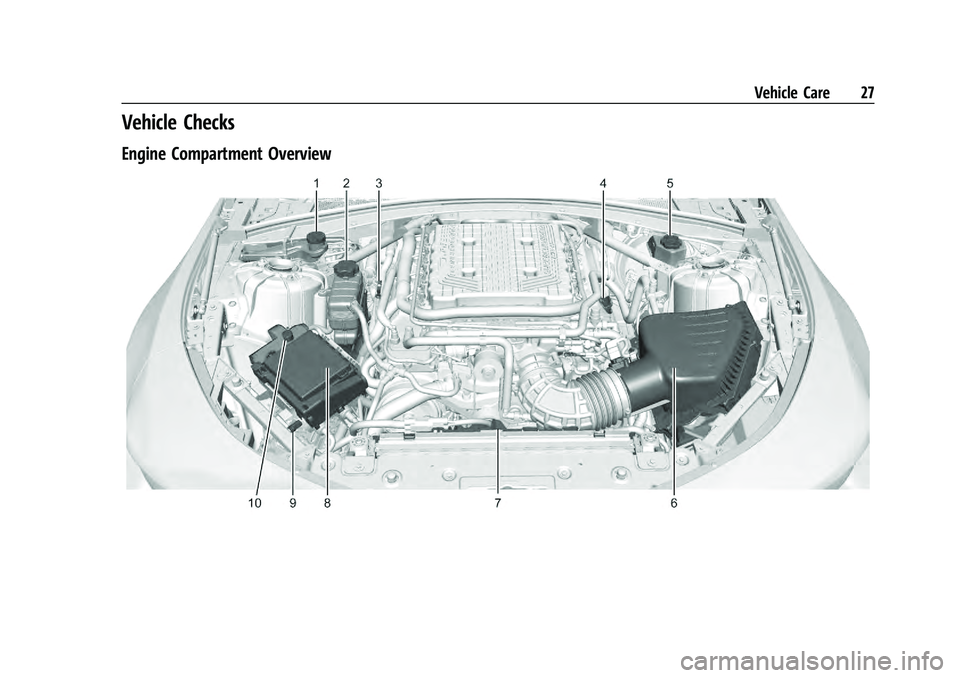
Chevrolet Camaro High Performance Owner Manual Supplement (GMNA-
Localizing-U.S./Canada/Mexico-14584225) - 2021 - CRC - 9/30/20
Vehicle Care 27
Vehicle Checks
Engine Compartment Overview
Page 29 of 49

Chevrolet Camaro High Performance Owner Manual Supplement (GMNA-
Localizing-U.S./Canada/Mexico-14584225) - 2021 - CRC - 9/30/20
28 Vehicle Care
1. Windshield Washer Fluid Reservoir.
2. Engine Coolant Surge Tank andPressure Cap.
3. Engine Oil Dipstick.
4. Engine Oil Fill Cap.
5. Brake/Clutch Fluid Reservoir.
6. Engine Air Cleaner/Filter.
7. Engine Cooling Fan (Out of View).
8. Engine Compartment Fuse Block.
9. Negative (–) Battery Terminal.
10. Positive (+) Battery Terminal.
Engine Oil
To ensure proper engine performance and
long life, careful attention must be paid to
engine oil. Following these simple, but
important steps will help protect your
investment:
.Use engine oil approved to the proper
specification and of the proper viscosity
grade. See “Selecting the Right Engine
Oil” in this section.
.Check the engine oil level regularly and
maintain the proper oil level. See
“Checking Engine Oil” and“When to Add
Engine Oil” in this section.
.Change the engine oil at the appropriate
time. See“Engine Oil Life System” in the
owner’s manual.
.Always dispose of engine oil properly. See
“What to Do with Used Oil” in this
section.
Checking Engine Oil
Check the engine oil level regularly, every
650 km (400 mi), especially prior to a long
trip. The engine oil dipstick handle is a loop.
See Engine Compartment Overview 027 for
the location.
{Warning
The engine oil dipstick handle may be
hot; it could burn you. Use a towel or
glove to touch the dipstick handle.
If a low oil Driver Information Center (DIC)
message displays, check the oil level.
Follow these guidelines:
.To get an accurate reading, park the
vehicle on level ground. Check the engine
oil level after the engine has been off for
at least two hours. Checking the engine
oil level on steep grades or too soon after
engine shutoff can result in incorrect readings. Accuracy improves when
checking a cold engine prior to starting.
Remove the dipstick and check the level.
.If unable to wait two hours, the engine
must be off for at least 15 minutes if the
engine is warm, or at least 30 minutes if
the engine is not warm. Pull out the
dipstick, wipe it with a clean paper towel
or cloth, then push it back in all the way.
Remove it again, keeping the tip down,
and check the level.
When to Add Engine Oil
If the oil is below the cross-hatched area at
the tip of the dipstick and the engine has
been off for at least 15 minutes, add 1 L (1
qt) of the recommended oil and then
recheck the level. See
“Selecting the Right
Engine Oil” later in this section for an
explanation of what kind of oil to use. For
engine oil crankcase capacity, see Capacities
and Specifications 043.
Page 30 of 49
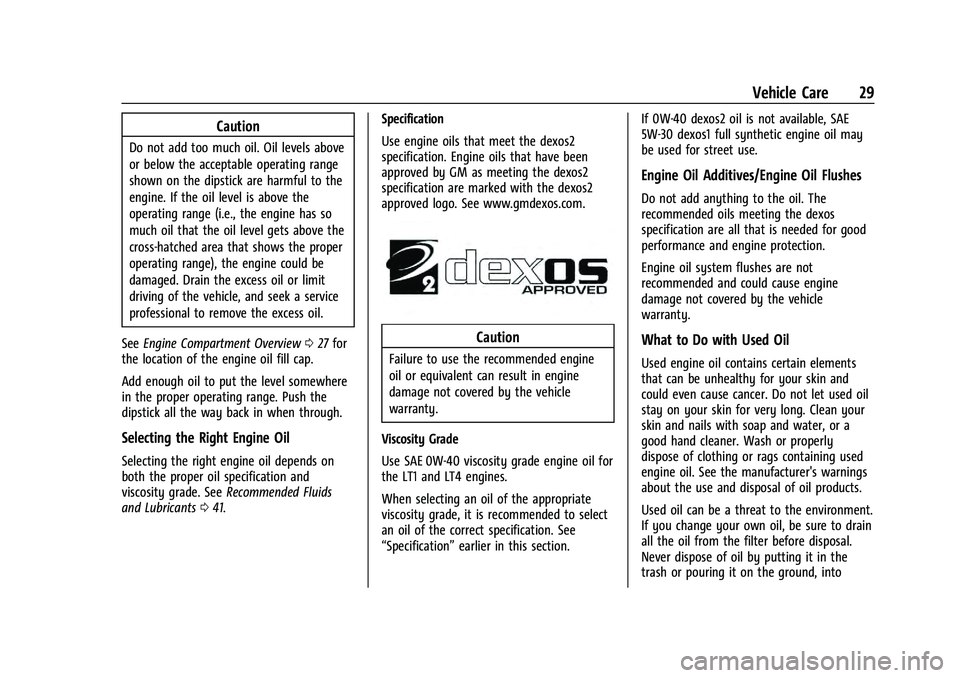
Chevrolet Camaro High Performance Owner Manual Supplement (GMNA-
Localizing-U.S./Canada/Mexico-14584225) - 2021 - CRC - 9/30/20
Vehicle Care 29
Caution
Do not add too much oil. Oil levels above
or below the acceptable operating range
shown on the dipstick are harmful to the
engine. If the oil level is above the
operating range (i.e., the engine has so
much oil that the oil level gets above the
cross-hatched area that shows the proper
operating range), the engine could be
damaged. Drain the excess oil or limit
driving of the vehicle, and seek a service
professional to remove the excess oil.
See Engine Compartment Overview 027 for
the location of the engine oil fill cap.
Add enough oil to put the level somewhere
in the proper operating range. Push the
dipstick all the way back in when through.
Selecting the Right Engine Oil
Selecting the right engine oil depends on
both the proper oil specification and
viscosity grade. See Recommended Fluids
and Lubricants 041. Specification
Use engine oils that meet the dexos2
specification. Engine oils that have been
approved by GM as meeting the dexos2
specification are marked with the dexos2
approved logo. See www.gmdexos.com.
Caution
Failure to use the recommended engine
oil or equivalent can result in engine
damage not covered by the vehicle
warranty.
Viscosity Grade
Use SAE 0W-40 viscosity grade engine oil for
the LT1 and LT4 engines.
When selecting an oil of the appropriate
viscosity grade, it is recommended to select
an oil of the correct specification. See
“Specification” earlier in this section. If 0W-40 dexos2 oil is not available, SAE
5W-30 dexos1 full synthetic engine oil may
be used for street use.
Engine Oil Additives/Engine Oil Flushes
Do not add anything to the oil. The
recommended oils meeting the dexos
specification are all that is needed for good
performance and engine protection.
Engine oil system flushes are not
recommended and could cause engine
damage not covered by the vehicle
warranty.
What to Do with Used Oil
Used engine oil contains certain elements
that can be unhealthy for your skin and
could even cause cancer. Do not let used oil
stay on your skin for very long. Clean your
skin and nails with soap and water, or a
good hand cleaner. Wash or properly
dispose of clothing or rags containing used
engine oil. See the manufacturer's warnings
about the use and disposal of oil products.
Used oil can be a threat to the environment.
If you change your own oil, be sure to drain
all the oil from the filter before disposal.
Never dispose of oil by putting it in the
trash or pouring it on the ground, into